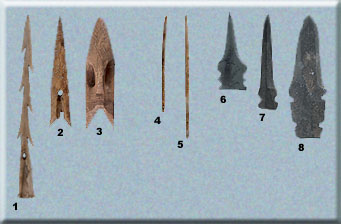| Lost Visions, Forgotten Dreams |  |
About 2,500 years ago, the Palaeo-Eskimo way of life underwent a rapid change. New styles of weapons and tools began to be used, and others disappeared. The Arctic climate was becoming colder than it had been during earlier times, and probably colder than it is at present. The cooling climate must have resulted in changes in the distribution of the animals on which the Palaeo-Eskimos depended for their survival, as well as important changes in the seasonal distribution of sea ice and open water. Traditional Arctic peoples had so little "technological insulation" between themselves and their environment that an unexpected change must have forced on them a simple choice between rapid adaptation or death from cold and starvation.
 |
1.Fish Spear 2.Harpoon Head 3.Harpoon Head 4.Needle 5.Needle 6.Blade 7.Knife 8.Blade |
The new way of life that developed at this time is known as the Dorset culture. It was named in 1925 by Diamond Jenness, an anthropologist at the National Museum of Canada, who examined a collection of artifacts dug up near the community of Cape Dorset, on Baffin Island. Some of the artifacts from this original collection are shown in the exhibit.
| Seal pendant Ivory Cape Dorset  |
Dorset culture artifacts obviously reflect a way of life that was richer and more secure than that of earlier Palaeo-Eskimos. The change seems to relate to the Dorset people's ability and efficiency in hunting sea mammals - seals, walrus, beluga and narwhal. The largest and most enduring Dorset settlements are found in areas where sea mammals are abundant today, and there is little evidence of Dorset occupation in interior regions. The increased emphasis on the hunting of sea mammals is evidenced by the appearance of new types of harpoons, as well as equipment for working and living on the sea ice: sled shoes of bone or ivory, large knives for cutting snow blocks and crampons for walking on ice. The appearance of lamps carved from soapstone indicates that the Dorset people were able to accumulate enough sea mammal oil for use as a fuel to supply winter heat and light. Trade over long distances is suggested by the widespread occurrence of artifacts made from jade, crystal quartz, native copper and meteoric iron.


